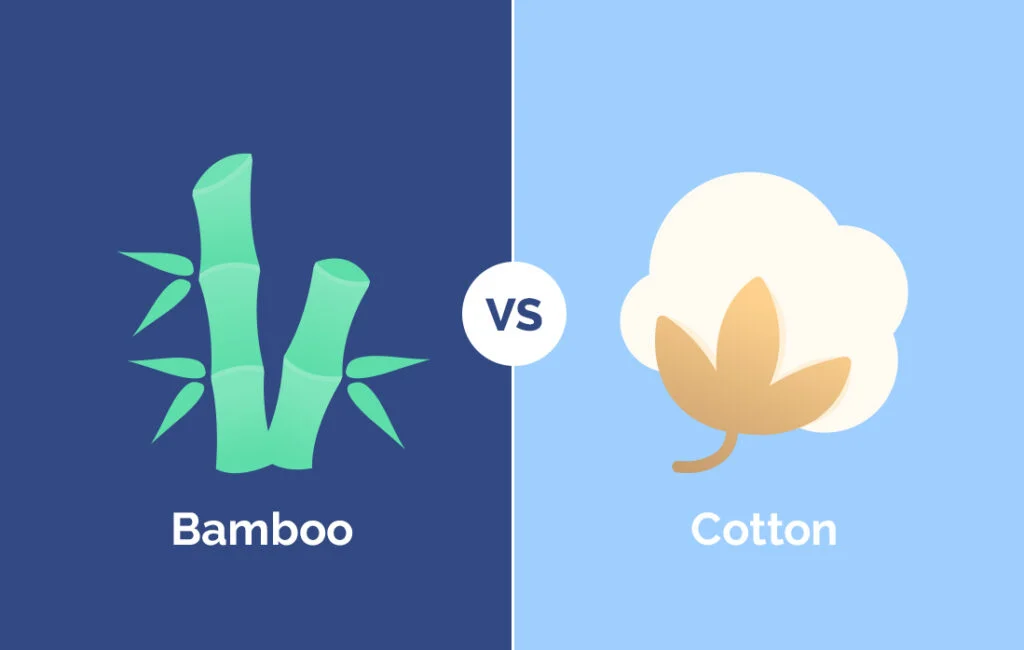
Once you’ve picked out the perfect mattress, the next step is hunting for the perfect set of sheets. Nowadays, there seems to be so many different options that you may not even know where to begin.
Two of the most popular materials for sheets are bamboo and cotton. While these two materials share similarities, they have some key differences that set them apart. These differences may be the deciding factor for which sheet type is best for you. In this article, I’ll cover the similarities and differences between bamboo and cotton sheets, as well as the pros and cons of both.
Bamboo Sheets
Bamboo sheets are one of the most popular types of sheets on the market. Usually, these sheets are made of bamboo rayon, lyocell, and modal — semi-synthetic fabrics derived from the fibers of the bamboo plant. They’re hypoallergenic, antifungal, and antibacterial, which fights against things that can damage your mattress, like mold and mildew. These sheets are incredibly soft and breathable, which is another reason why they’re so beloved.
One of the main draws to these sheets is their sustainability. The bamboo plant is known for being a fast-growing plant that doesn’t rely on irrigation, pesticides, or fertilizers, so it doesn’t require as much water or cultivation as other crops. However, the chemical processes used to extract cellulose from bamboo fiber to spin into fabric can have some detrimental environmental impacts.
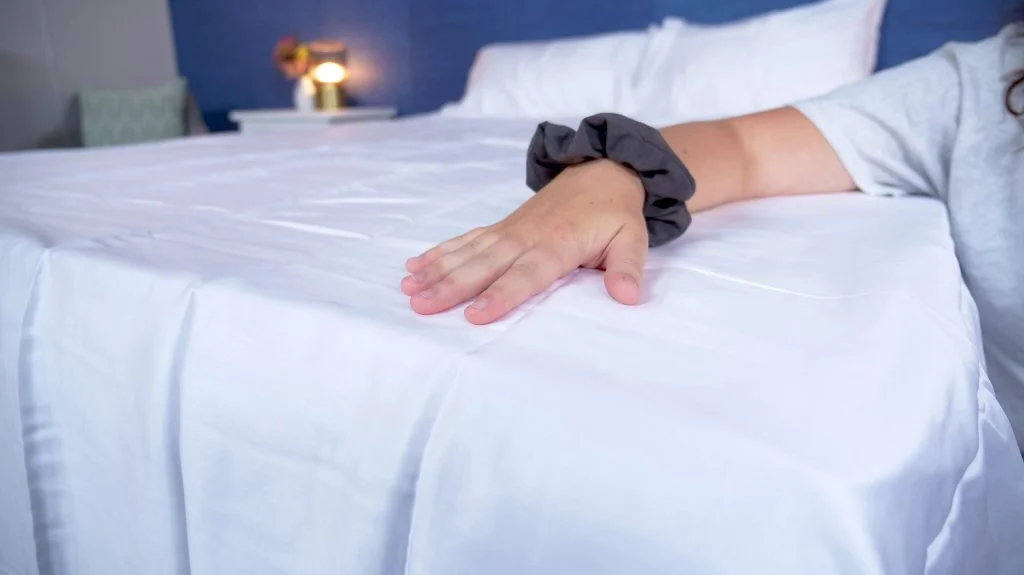
Types of Bamboo Sheets
Bamboo sheets are typically weaved in one of three ways. The type of weaves can affect the way the sheets feel and perform. Here are some of the most common types of weaves found in bamboo fabric:
Percale: Percale is a style of weave in which the threads are woven one over, one under.. This weave gives the sheets a matte finish and a crisper texture. These types of sheets are known for being lightweight and breathable, since the weave is looser than other styles, which can make them a good choice for hot sleepers.
Sateen: Sheets made with the sateen weave style are thicker and heavier, which is ideal for those looking to keep warm at night. Unlike percale, a sateen weave involves weaving multiple threads over and one under, such as three over and one under. They have a silky feel and are known for being durable and wrinkle-resistant.
Twill: This weave style can be easily identified by its diagonal ribbing, which is the same style used to make your denim jeans. These sheets are especially durable, yet still lightweight and cooling. This type of sheet will feel slightly textured due to the ribbed weaving pattern.
Pros & Cons of Bamboo Sheets
No two sleepers are exactly the same, so the sheets that work for one person may not work for another. In this section, I’ll go over who these sheets may be a good choice for and who they may not be the best for.
Pros of Bamboo Sheets
- Breathable: Bamboo fibers make this fabric super light and breathable, which is a plus for those who sleep hot. The fabric is also moisture-wicking, so sweaty sleepers shouldn’t have an issue.
- Soft: You may not immediately think “soft” when you think of a bamboo stalk, but the bamboo fabrics are ultra-soft and cozy. This is because the cellulose of the fibers is extracted and then spun into a viscous fabric, which feels similar to silk.
- Durable: The fibers from bamboo are known for being extremely durable. Bamboo sheets have a reputation for lasting a long time and not tearing or pilling easily.
- Eco-friendly: The low impact of growing the raw material used in bamboo sheets is what makes some consider these an eco-friendly option.
Cons of Bamboo Sheets
- Expensive: Bamboo bed sheets typically cost anywhere from $50 to $200, which makes them more expensive than cheaper materials like polyester, but on par with higher quality materials like cotton. A pure bamboo sheet may be more expensive than bamboo sheets mixed with another textile.
- Easily wrinkled: Bamboo bedding is often prone to wrinkling, which is not ideal if presentation is very important to you. Sateen weaves are more wrinkle-resistant than percale.
- Chemical processing: The process of cultivating bamboo plants is eco-friendly, but harsh chemical processing is required to turn the fibers into fabric in the viscose process. . This is when the bamboo is dissolved so the extracted cellulose can be spun into fibers.
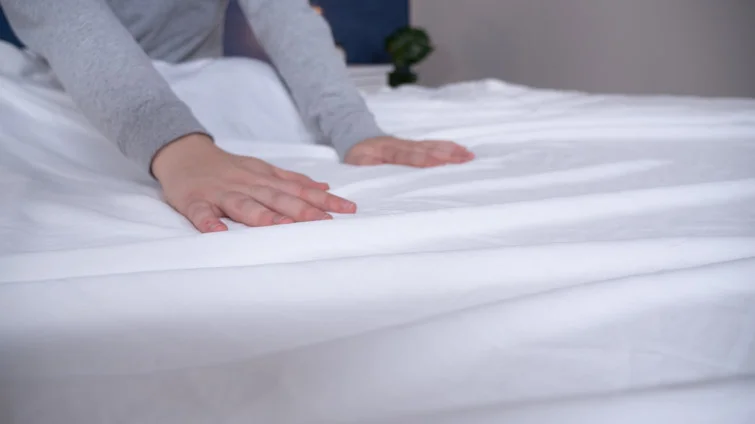
Cotton Sheets
A type of sheet that you’re likely more familiar with is the cotton sheet. These sheets are a classic and have been used for decades. People love these sheets because they’re soft and breathable while also being durable and easy to clean.
Cotton sheets are made from the natural fibers of the cotton plant, but the type of cotton used can vary. These sheets are highly versatile and can range from cheap to expensive depending on the type of cotton used and the thread count.
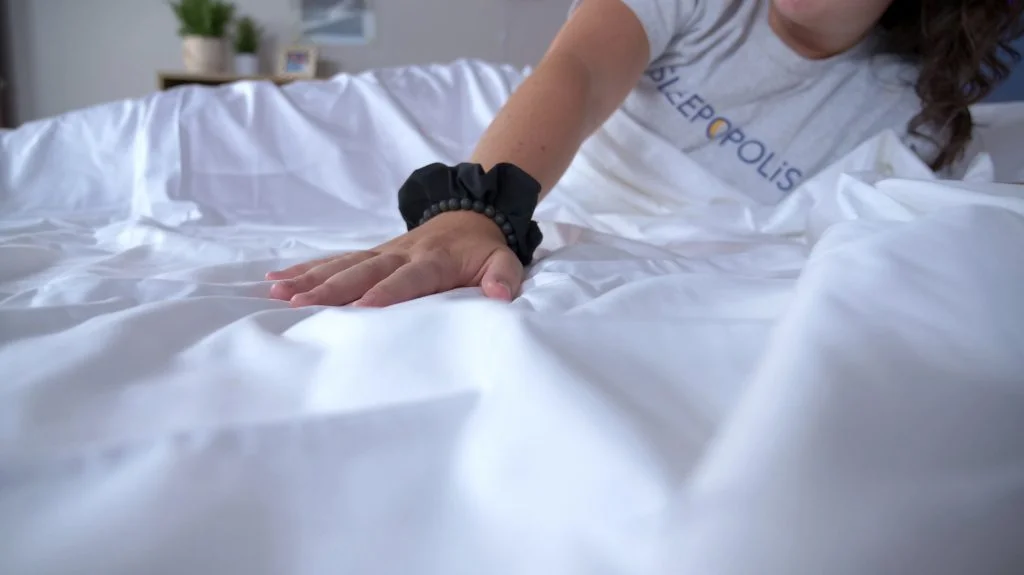
Types of Cotton Sheets
Like bamboo sheets, cotton sheets also have different weave styles that can affect their performance and feel. Here are four of the most common types of weaving:
Percale: The percale weaving style aids in making these sheets super lightweight and breathable. For those who tend to sleep hot throughout the night, breathable sheets can help keep you cool. This weave style gives the sheets a matte finish.
Sateen: A sateen weave makes the sheet thicker and heavier than the percale, so it isn’t as ideal for hot sleepers. However, it may be a good option for those who need to keep warm at night. This weave gives the sheets a luxurious feel and shinier sheen.
Twill: This weave can be identified by its ribbed diagonal lines that resemble the ones found in denim. The twill weave makes for extremely durable sheets that are heavy and warm.
Jersey: Jersey cotton actually isn’t a type of weave — it’s knit. However, this type of cotton knit is extremely popular, and you may encounter it while browsing for cotton sheets. Jersey sheets have a T-shirt-like feel that is lightweight and stretchy.
Pros & Cons of Cotton Sheets
Cotton sheets may be an excellent choice for some sleepers but less than ideal for others. In this section, I’ll review some pros and cons and who this type of sheet may or may not be best suited for.
Pros of Cotton Sheets
- Breathable: Traditional cotton sheets are known for being cool and crisp. Being a natural fiber, they are lightweight and breathable, which is great for those who tend to sleep hot during the night.
- Durable: These sheets are a good choice for anyone wanting their sheets to last for many years. The twill weave style is especially durable for cotton sheets. Cotton sheets are typically strong and shouldn’t wear out easily.
- Easy to clean: Cotton sheets are super easy to take care of and don’t require special care or dry cleaning. However, you should always check the instructions from the manufacturer on what temperature or cycle to wash them on.
- Softer over time: These sheets often become softer over time. With each wash, cotton sheets can become softer to the touch.
Cons of Cotton Sheets
- Sometimes wrinkly: Depending on the weave style, cotton sheets are often prone to becoming wrinkly. Some weaves don’t wrinkle quite as easily, such as sateen.
- May shrink: Cotton is a material that is notorious for its shrinking abilities. Many of us have lost beloved cotton clothing to shrinkage from the dryer. The same thing can happen with your cotton sheets, so always read the recommended care instructions to ensure you don’t accidentally shrink them in the dryer.
- Not environmentally friendly: The process of harvesting the cotton plant is typically not environmentally friendly. A lot of water is usually used during the irrigation process, and pesticides can also be used during manufacturing. However, one environmental benefit of organic cotton is it is biodegradable.
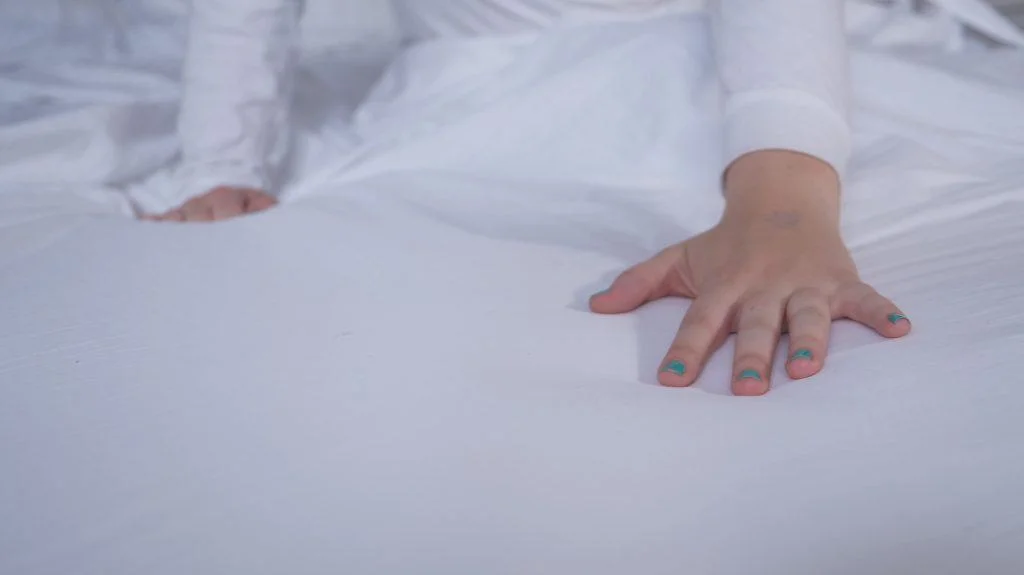
Bamboo vs Cotton Sheets
Bamboo and cotton both make great materials for comfortable sheets. They both use natural materials that are designed to help regulate your temperature throughout the night and prevent overheating. In addition, both these sheets are extremely durable and should last a long time with proper care. These two sheet types are also similar in the weave styles they’re made with.
Thread Count
The thread count of your sheets is something you’ll want to consider before purchasing. It is a common belief that a high thread count always indicates higher quality. However, this is not always the case. Fiber length is often more telling than thread count when assessing cotton sheets. For example, long-staple cotton creates smoother and softer surfaces than short-staple cotton.
Different weave styles also naturally have lower or higher thread counts. Percale fabrics, with a one-over-one-under weave, naturally have a lower thread count than sateen fabrics, which weave multiple threads over and one under. Additionally, there can be benefits to lower thread count. For example, sheets with a lower thread count also tend to be crisper and more breathable.
Check out our guide to all things thread count for a more in-depth breakdown of this important factor.
Comfort
Comfort is a pretty subjective factor, as what may be comfortable to one person may be very uncomfortable to someone else. Bamboo sheets in general should feel pretty soft to the touch. Cotton sheets can be very soft as well, but their feel is more subject to change depending on the quality and style of weave. If they’re a high-quality set of sheets made with long-staple cotton, they are more likely to feel soft and comfortable than low-quality cotton sheets, which may deteriorate and pill more quickly. .
Durability
Both bamboo and cotton sheets are known to be extremely durable fabrics.. Both types of sheets should be able to last a long time if they’re taken care of properly. However, cheaper cotton sheets won’t be quite as durable as bamboo sheets.
Care
Luckily, both bamboo and cotton sheets are easy to take care of and require little maintenance. However, it’s more likely that you’ll find a more detailed care routine is necessary for bamboo sheets as they tend to wrinkle easier than cotton ones.
Cost
The price point of both bamboo and cotton sheets can vary. Sheets that are made entirely of bamboo tend to be more expensive than bamboo sheets made with a blend of materials. Cotton can be relatively cheap, but it can also be hundreds of dollars — there is a wide range depending on the quality of the cotton. Luxury sheets, like those made with Egyptian cotton, are known for being particularly expensive.
FAQs
What is the downside to bamboo sheets?
Bamboo sheets can sometimes be more expensive than other materials and more prone to wrinkling. Also, the process of breaking down the bamboo into fibers often uses chemicals that can be harmful to the environment.
Is bamboo better than cotton?
Not necessarily. Some sleepers may prefer bamboo to cotton, while others may prefer to sleep on cotton. It’s ultimately a personal preference.
What is better to sleep in bamboo or cotton?
Neither sheet type is “better” than the other. It all comes down to which you personally prefer.
Is bamboo cooler than cotton sheets?
Both sheet types are breathable and should help with cooling. However, the cooling abilities are largely dependent on the weave style. For example, percale should be breathable for both types of sheets, and twill should be less breathable for both types.
Is bamboo healthier than cotton?
Bamboo is generally a better option for those who tend to have allergies. It is naturally hypoallergenic and fights against fungus and bacteria. The way bamboo is initially farmed is also healthier for the environment.
Conclusion
Bamboo and cotton sheets are both popular for a reason — they’re excellent choices. While these sheets tend to perform very similarly in many areas, there are some distinct differences that may be the reason why you choose one over the other. Here are my final recommendations for who these sheets may work best for:
Who Bamboo Sheets Are Best For
- People with allergies: The hypoallergenic properties of bamboo linen make them an easy choice for people who struggle with dust mite allergies or have sensitive skin.
- People seeking softness: If a smooth and soft feel is your top priority for bed sheets, then bamboo sheets can definitely fulfill that requirement.
- Eco-conscious shoppers: Bamboo is easy to grow without irrigation or pesticides, so it’s a more eco-friendly option for those who prioritize environmentally-friendly products. However, the processing required to make sheets can be detrimental to the environment.
Who Cotton Sheets Are Best For
- Hot sleepers: Cotton sheets are great for hot sleepers who tend to overhead during the night. These sheets are lightweight and breathable, which can aid in cooling.
- People wanting soft sheets: These sheets get softer and softer the more you use and wash them. This may be for you if you want sheets that will only get better with time.
- Budget shoppers: Cotton sheet sets vary a lot in price, so you can find cheap cotton sheets that won’t break the bank.
More Types of Sheets to Consider
If you’re curious to learn more about other types of sheets on the market, look no further! We have plenty of sheet guides to explore. Here are a few to get you started:


























